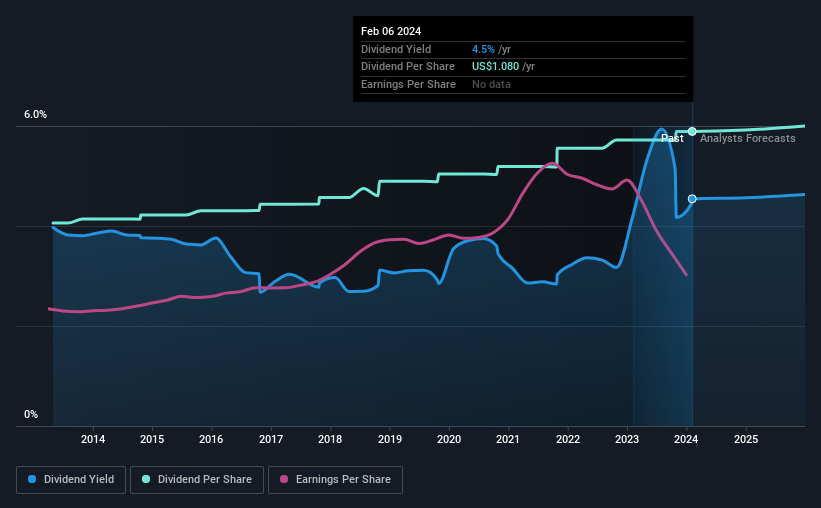Why It Might Not Make Sense To Buy Arrow Financial Corporation (NASDAQ:AROW) For Its Upcoming Dividend
It looks like Arrow Financial Corporation (NASDAQ:AROW) is about to go ex-dividend in the next 2 days. The ex-dividend date is one business day before the record date, which is the cut-off date for shareholders to be present on the company's books to be eligible for a dividend payment. The ex-dividend date is of consequence because whenever a stock is bought or sold, the trade takes at least two business day to settle. Accordingly, Arrow Financial investors that purchase the stock on or after the 9th of February will not receive the dividend, which will be paid on the 23rd of February.
The company's next dividend payment will be US$0.27 per share. Last year, in total, the company distributed US$1.08 to shareholders. Calculating the last year's worth of payments shows that Arrow Financial has a trailing yield of 4.5% on the current share price of US$23.77. We love seeing companies pay a dividend, but it's also important to be sure that laying the golden eggs isn't going to kill our golden goose! That's why we should always check whether the dividend payments appear sustainable, and if the company is growing.
See our latest analysis for Arrow Financial
If a company pays out more in dividends than it earned, then the dividend might become unsustainable - hardly an ideal situation. Arrow Financial paid out 60% of its earnings to investors last year, a normal payout level for most businesses.
Companies that pay out less in dividends than they earn in profits generally have more sustainable dividends. The lower the payout ratio, the more wiggle room the business has before it could be forced to cut the dividend.
Click here to see the company's payout ratio, plus analyst estimates of its future dividends.
Have Earnings And Dividends Been Growing?
Companies with falling earnings are riskier for dividend shareholders. If earnings decline and the company is forced to cut its dividend, investors could watch the value of their investment go up in smoke. That's why it's not ideal to see Arrow Financial's earnings per share have been shrinking at 4.0% a year over the previous five years.
The main way most investors will assess a company's dividend prospects is by checking the historical rate of dividend growth. Arrow Financial has delivered an average of 3.8% per year annual increase in its dividend, based on the past 10 years of dividend payments. That's interesting, but the combination of a growing dividend despite declining earnings can typically only be achieved by paying out more of the company's profits. This can be valuable for shareholders, but it can't go on forever.
To Sum It Up
From a dividend perspective, should investors buy or avoid Arrow Financial? We're not overly enthused to see Arrow Financial's earnings in retreat at the same time as the company is paying out more than half of its earnings as dividends to shareholders. This is not an overtly appealing combination of characteristics, and we're just not that interested in this company's dividend.
With that in mind though, if the poor dividend characteristics of Arrow Financial don't faze you, it's worth being mindful of the risks involved with this business. In terms of investment risks, we've identified 1 warning sign with Arrow Financial and understanding them should be part of your investment process.
If you're in the market for strong dividend payers, we recommend checking our selection of top dividend stocks.
Have feedback on this article? Concerned about the content? Get in touch with us directly. Alternatively, email editorial-team (at) simplywallst.com.
This article by Simply Wall St is general in nature. We provide commentary based on historical data and analyst forecasts only using an unbiased methodology and our articles are not intended to be financial advice. It does not constitute a recommendation to buy or sell any stock, and does not take account of your objectives, or your financial situation. We aim to bring you long-term focused analysis driven by fundamental data. Note that our analysis may not factor in the latest price-sensitive company announcements or qualitative material. Simply Wall St has no position in any stocks mentioned.

